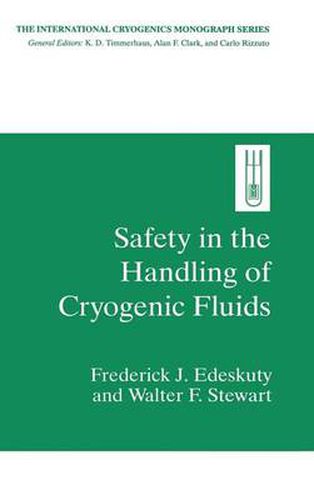Readings Newsletter
Become a Readings Member to make your shopping experience even easier.
Sign in or sign up for free!
You’re not far away from qualifying for FREE standard shipping within Australia
You’ve qualified for FREE standard shipping within Australia
The cart is loading…






This title is printed to order. This book may have been self-published. If so, we cannot guarantee the quality of the content. In the main most books will have gone through the editing process however some may not. We therefore suggest that you be aware of this before ordering this book. If in doubt check either the author or publisher’s details as we are unable to accept any returns unless they are faulty. Please contact us if you have any questions.
The importance of safety in any scientific endeavor is never in question. However, when cryogenic temperatures are involved, safety is especially important. In addition to observing the normal precautions, one must also take into account the variations of physical properties that occur at low temperatures. At these tempera tures, some properties not only exhibit large differences from their normal values but also can vary widely over a small temperature range. Before any cryogenic project is started, a thorough knowledge of the possible hazards is necessary. Only in this way can the safest operation be attained. Over the hundred-year history of cryogenic research, this has been shown to be the case. Keeping this requirement in mind is an essential ingredient in the quest for accident-free work. The past four or five decades have seen a great expansion of cryogenic technology. Cryogenic liquids, such as oxygen, nitrogen, hydrogen, and helium, have become commonly used in a number of different applications and are easily available in any part of the United States and, indeed, almost anywhere in the world. Not only are these liquids available, they have become less expensive and also available in ever larger quantities. As quantities increase, so also do the conse quences of mishaps. The future seems to hold promise of ever larger and more widespread use of the common cryogens. Thus, the importance of safety also increases as time progresses.
$9.00 standard shipping within Australia
FREE standard shipping within Australia for orders over $100.00
Express & International shipping calculated at checkout
This title is printed to order. This book may have been self-published. If so, we cannot guarantee the quality of the content. In the main most books will have gone through the editing process however some may not. We therefore suggest that you be aware of this before ordering this book. If in doubt check either the author or publisher’s details as we are unable to accept any returns unless they are faulty. Please contact us if you have any questions.
The importance of safety in any scientific endeavor is never in question. However, when cryogenic temperatures are involved, safety is especially important. In addition to observing the normal precautions, one must also take into account the variations of physical properties that occur at low temperatures. At these tempera tures, some properties not only exhibit large differences from their normal values but also can vary widely over a small temperature range. Before any cryogenic project is started, a thorough knowledge of the possible hazards is necessary. Only in this way can the safest operation be attained. Over the hundred-year history of cryogenic research, this has been shown to be the case. Keeping this requirement in mind is an essential ingredient in the quest for accident-free work. The past four or five decades have seen a great expansion of cryogenic technology. Cryogenic liquids, such as oxygen, nitrogen, hydrogen, and helium, have become commonly used in a number of different applications and are easily available in any part of the United States and, indeed, almost anywhere in the world. Not only are these liquids available, they have become less expensive and also available in ever larger quantities. As quantities increase, so also do the conse quences of mishaps. The future seems to hold promise of ever larger and more widespread use of the common cryogens. Thus, the importance of safety also increases as time progresses.